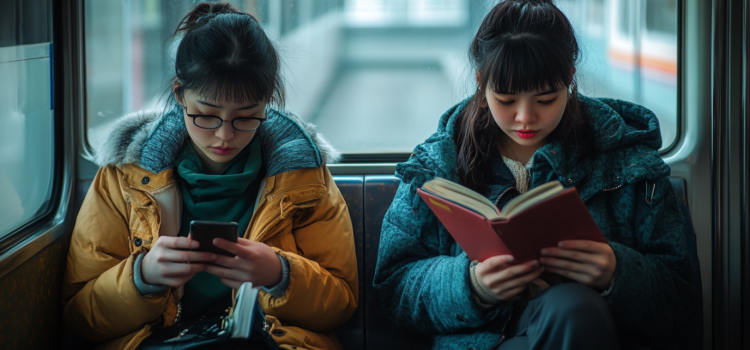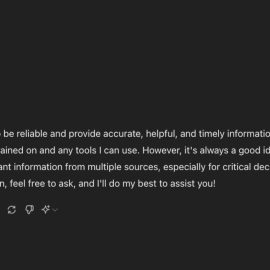
What happens to our brains when we read on screens versus paper? How can we balance digital convenience with deeper comprehension skills?
In her book Proust and the Squid, Maryanne Wolf explores the significant disadvantages of digital reading alongside its benefits. She explains how our brains adapt differently to online reading, with platforms encouraging skimming rather than deep reading.
Below, find Wolf’s practical strategies for parents, teachers, and readers to maintain deep reading abilities while still embracing the digital world.
The Disadvantages of Digital Reading
The digital age will change our brains and our thinking skills. Wolf isn’t quite sure how, but she writes about the various disadvantages of digital reading despite its advantages.
Discussing upsides, Wolf writes that digital reading could promote strong associative thinking—the ability to make connections across many topics or themes. She also says that digital mediums offer accessibility features, such as adjustable text size, read-aloud options, customized learning support, and interactive engagement with texts—things not possible with an inert, physical book.
Despite these potential upsides, Wolf worries that digital reading could have major downsides. Because the internet lets you quickly scan and bounce among many different streams of information, it conditions you to think in a different way. Moving swiftly from article to article or social media post to social media post, you take things in less deeply but more broadly. Able to access most any piece of information almost immediately, you don’t stop as long to think or engage as critically with it.
Given that the internet encourages you to skim and bounce around quickly, Wolf says it might have these negative effects:
- Decreased attention span (trouble sticking with one thing, such as a book)
- Less capacity for analytical thinking—it becomes harder to think critically about the ideas in a text. For instance, you might struggle to understand an author’s argument (about, say, the merits of veganism), assess its soundness, and decide whether you agree.
- Less empathy—it gets harder to take other perspectives, relate deeply to an author’s ideas, and pick up on the meaning and emotion in what you read.
These skills are precisely those that humankind developed through traditional literacy. To preserve them, we have to make sure we don’t abandon deeper, slower, offline reading and writing altogether.
How to Minimize the Disadvantages
Despite the downsides, Wolf doesn’t reject digital reading altogether. She suggests instead that we develop the capacity to effectively switch between slow, deep, traditional reading and quick, surface-level, online reading.
Wolf recommends specific ways that parents and educators can help their children achieve this balance. First, parents should continue reading physical books with children and help them establish dedicated time for deep, traditional reading.
(Shortform note: Experts recommend a few easy ways to help kids develop a love of reading. For one, you can set up a cozy space, such as a reading nook, which can help make reading more relaxing. You might also choose a specific time to read to your kids, such as before bed. Additionally, lead by example by reading regularly yourself—and by shutting off the TV or putting down your phone. This sends the message that reading is its own form of enjoyment, and that it can be as good or better than screen-based entertainment.)
Wolf says that, meanwhile, educators need to teach explicit strategies for both digital and traditional reading, helping students recognize when each type of reading is appropriate and developing exercises that build deep reading skills.
(Shortform note: Perhaps in response to concerns like Wolf’s, some educators have begun to teach “critical digital literacy.” This approach involves teaching what’s been called “online civic reasoning”: the ability to evaluate online sources of information, understand how people create and spread online content, and consciously shift between different reading modes. Some programs explicitly teach students to recognize when skimming is appropriate versus when deeper engagement is needed—taking deliberate action to address the issue rather than assuming people will just naturally develop traditionally and digitally literate brains.)
While parents and educators can help, Wolf stresses that society must actively work to preserve spaces for deep reading while embracing digital literacy’s benefits. This means maintaining libraries and physical books alongside digital resources. It also means continuing to research how different kinds of digital, online reading—such as social media posts, blog articles, or ebooks—affect our brains.
(Shortform note: Relatedly, ongoing research explores how to best design libraries to support patrons’ needs. One study found that students develop emotional bonds with study spaces that help them feel comfortable and productive. Effective library spaces should be both functional as well as welcoming and safe. Some libraries now deliberately design distinct zones optimized for different reading modes—quiet, reflective spaces for sustained reading and more collaborative areas for interactive work. Library spaces often also set digital commons (areas with computers and tech) apart from the stacks and sitting areas for deep reading of physical books.)
We’re at a crucial turning point, Wolf argues. Our brains will change to suit how we read, and if we’re not careful, we might lose the deep reading capabilities that have been crucial to human intellectual development. However, this same plasticity means we can consciously shape how our brains evolve. By understanding how the brain learns to read and deliberately preserving the conditions for deep reading while embracing digital literacy’s benefits, we can potentially create reading brains that are more capable than ever before.
| Studies and Strategies for a Digital World Research published since the 2007 publication of Proust and the Squid has painted a mixed picture of how well our brains are adapting to the digital age. There’s some support for Wolf’s concern that consuming online information would, for instance, reduce the time we spend thinking deeply and critically. Other studies argue that digital media clearly impacts our mental and emotional health, explaining that the impact depends on what you do online and for how long. However, researchers haven’t yet established clear, causal relationships between specific activities (such as social media scrolling) and specific brain changes. This is because many studies on, for instance, social media, rely on self-reporting—a research method known for bias and error. Until we have better research, we don’t know precisely how the internet affects our brains. Either way, there’s no going back to life before tech. But there are plenty of ways to adapt to the challenges it poses. For one, there’s widespread agreement that practices such as meditation and exercise both help your brain stay healthy and sharp. You can also follow Cal Newport’s advice in Digital Minimalism to reduce, get intentional about, and take control of your tech use. This approach, he argues, will help you reclaim tech-free solitude, healthy relationships, and enjoyable leisure time. |






